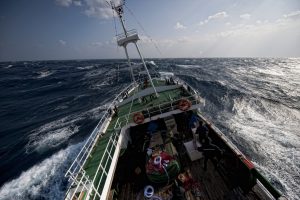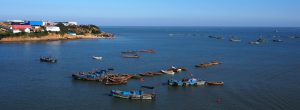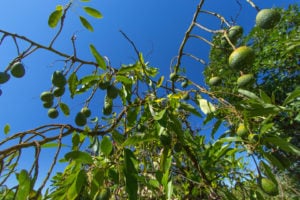The best season to harvest sea cucumbers along the coast of the Yellow and Bohai seas is when autumn turns to winter and the waters become icy cold.
Grasping hold of the boat as he surfaces, 40-year-old Wang Zhonghua puts one foot on the deck and pulls himself on board. Untying his oxygen tank and the heavy lead weights he uses to walk along the sea floor, he breathes a long sigh of relief. It’s hard work.
At six in the morning, Wang and three of his colleagues had set out from their homes on the Changshan Islands near the coastal city of Dalian, Liaoning province. Every day during the harvest season, they dive 20 to 30 metres beneath the waves and scour the muddy seabed for sea cucumbers – creatures that look like small, grey mangoes with little horns on their skin.
In Dalian, custom dictates that people eat sea cucumbers for 81 days straight when winter starts
The marine animal is a crucial part of northern Chinese cuisine. It is most often sold dried, and can cost more than 7,000 yuan (over US$1,000) per kilogram. In Dalian, custom dictates that people eat sea cucumbers for 81 days straight when winter starts; some people stew the animals and eat them for breakfast with rice or porridge, believing that they’re good for health.
But harvesting sea cucumbers is a different story. Wang wears thick, cotton-padded layers beneath his wetsuit, but they make little difference against the frigid sea. Even when you clap your hands or hit yourself, he says, “you can’t feel any pain. That’s how cold it gets.”
After several years Wang started to notice pain in his right leg and purple bruises whenever he’d come out of the water. He was diagnosed with osteonecrosis of the thighbone, a condition caused by a lack of blood flow. His doctor thinks it’s because Wang repeatedly exposes his body to high water pressure, and suggested he change his line of work. He takes painkillers instead. But nothing else pays as well.

Last year, Wang rented a taxi and would work two jobs, collecting sea cucumbers in the morning and driving his taxi in the afternoon. But he says, “There’s not much money in cab driving – maybe 4,000 or 5,000 yuan a month if you work every day, and I have a wife and kid to look after”. Collecting sea cucumbers for a few months could earn him enough to pay for a whole year’s living expenses, so Wang shelved any plans of switching careers.
Sometimes, the islands’ divers die in underwater accidents. In April last year, one of Wang’s friends passed away. “No one knows what happened down there,” he says matter-of-factly, “and no one who does this job knows how long they can keep on doing it”.

Records of people eating sea cucumbers for medicinal purposes date back over 2,000 years to the Han Dynasty, with the animal being described in texts as beneficial to your organs. But sea cucumbers only became truly popular in recent decades as ordinary Chinese people had more money to spend.
Residents of the Changshan Islands say that, in the past, you didn’t need to go diving for sea cucumbers because you could pick them off the seashore. Few locals thought the odd-looking creatures were particularly valuable until the consumption boom in the 1980s, when they became both increasingly expensive and scarce.
When wild sea cucumbers became hard to find, fishers switched to aquaculture, buying young sea cucumbers from breeders and scattering them along the sea floor. After about three years, the animals – which hardly move during their lifetimes – are ready to be harvested.
The fishery Wang works for was formerly the Dalian state-owned fishery production brigade. Tang Shijing, the fishery’s former head, was one of the first to start cultivating sea cucumbers in Dalian. At the time, in the 1970s, few saw the economic sense of the trade. Public consumption of sea cucumbers was still low. “What’s more, at the time, the oceans were teeming with fish – as if they’d never been exploited at all – so everyone wanted to go fishing,” Tang says.
Wang’s production brigade made its first forays into sea cucumber cultivation in the late 80s, constructing artificial reefs to create more suitable living environments. At the same time, people began turning the shallows into sea cucumber pools. The industry has grown to such an extent that every suitable stretch of coast in North China is now used for aquaculture, mostly to grow sea cucumbers.
This situation is cause for concern among ecologists. Coastline development has damaged over half of China’s coastal wetlands. These intertidal zones – which are submerged and exposed with the tide – are nutrient-rich areas that form stopover points for at least 33 “threatened” or “near threatened” waterbirds as they migrate between East Asia and Australia.
There are more than 1,200 known species of sea cucumber around the world. About 20 kinds are eaten in China, but the Japanese spiky sea cucumber is the most beloved, expensive, and widely cultivated.
Sea cucumbers, which feed on organic debris from the sludge of the ocean floor, are perhaps best-known outside of China for their peculiar defense strategy: When threatened, they expel some of their intestines in order to survive. They move slowly, covering only a few square metres of seabed during their entire lives, but their importance to the marine ecosystem shouldn’t be underestimated.

Dalian Ocean University lecturer Zhang Peng explains that sea cucumbers fill the same role as earthworms. They accelerate the decomposition of organic matter in the soil, and their own waste is food for microorganisms and other creatures that dwell on the seabed. In turn, they are food for marine animals above them in the food chain. However, most Chinese academic studies on sea cucumbers are focused on their breeding and nutritional value, with little attention paid to their survival in the wild.
China’s soaring consumption of sea cucumbers has contributed to a rise in their harvesting around the world. According to the “China Fishery Statistics Yearbook,” the country’s national output of cultivated sea cucumbers exceeded 200,000 tonnes in 2016. But that’s still not enough to satisfy demand, and so large amounts need to be imported.
From Ecuador to Indonesia, over 90% of the world’s tropical coastlines have joined the global trade in sea cucumbers. However, a 2011 study estimates that approximately 38% of the world’s sea cucumber fisheries are being overfished, and 20% are already depleted. Whenever one species of sea cucumber is overfished, fishers simply find another variety to take its place. After analysing 377 sea cucumber species, the IUCN in 2013 listed seven species as being “endangered” and nine species as “vulnerable”.

On the Chinese market, the phrase “caught in the wild” conjures up images of uncontaminated natural environments, but even the sea cucumbers that have been artificially placed on the sea floor are labelled “wild”. Truly wild sea cucumbers are becoming increasingly rare.
“There are hardly any [wild] sea cucumbers left in the shallows; you can only find them if you go farther out,” says Wang.
The story was first published by Sixth Tone and is republished here with permission.









